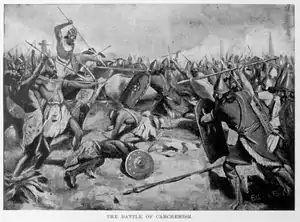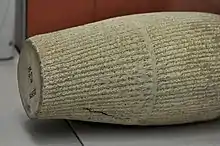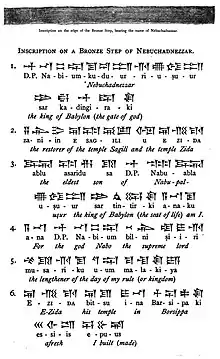Nebuchadnezzar II
Nebuchadnezzar II (/ˌnɛbjʊkədˈnɛzər/), also Nebuchadrezzar II[lower-alpha 1] (Babylonian cuneiform: ![]() Nabû-kudurri-uṣur, meaning "Nabu, watch over my heir"; Biblical Hebrew: נְבוּכַדְרֶאצַּר – Nəḇūḵaḏreʾṣṣar[lower-alpha 2] or נְבוּכַדְנֶאצַּר – Nəḇūḵaḏneʾṣṣar;[lower-alpha 3] Biblical Aramaic: נְבוּכַדְנֶצַּר – Nəḇūḵaḏneṣṣar[lower-alpha 4]), king of Babylon c. 605 BC – c. 562 BC, was the longest-reigning and most powerful monarch of the Neo-Babylonian Empire.[2][3]
Nabû-kudurri-uṣur, meaning "Nabu, watch over my heir"; Biblical Hebrew: נְבוּכַדְרֶאצַּר – Nəḇūḵaḏreʾṣṣar[lower-alpha 2] or נְבוּכַדְנֶאצַּר – Nəḇūḵaḏneʾṣṣar;[lower-alpha 3] Biblical Aramaic: נְבוּכַדְנֶצַּר – Nəḇūḵaḏneṣṣar[lower-alpha 4]), king of Babylon c. 605 BC – c. 562 BC, was the longest-reigning and most powerful monarch of the Neo-Babylonian Empire.[2][3]
| Nebuchadnezzar II | |
|---|---|
 An engraving with a royal inscription of Nebuchadnezzar II. Anton Nyström, 1901.[1] | |
| King of the Neo-Babylonian Empire | |
| Reign | c. 605 – c. 562 BC |
| Predecessor | Nabopolassar |
| Successor | Amel-Marduk |
| Born | c. 634 BC |
| Died | c. 562 BC (aged 71–72) |
| Spouse | Amytis of Media |
| Dynasty | Chaldean dynasty |
| Father | Nabopolassar |
His father Nabopolassar was an official of the Neo-Assyrian Empire who rebelled in 626 BC and established himself as the king of Babylon.[4][5] Nebuchadnezzar ascended the throne in 605 BC and subsequently fought several campaigns in the West, where Egypt was trying to organize a coalition against him. His conquest of Judah is described in the Bible's Books of Kings, Books of Chronicles and Book of Jeremiah.[6] His capital, Babylon, is the largest archaeological site in the Middle East.[7]
Nebuchadnezzar is identified in the Bible as the king responsible for destroying Solomon's Temple and initiating the Babylonian captivity, and is a significant character in the Book of Daniel.
Name

The English form Nebuchadnezzar is borrowed from its Hebrew form נְבוּכַדְנֶצַּר Neḇuchadneṣṣar in the Bible, whereas the original Akkadian name Nabû-kudurri-uṣur is currently understood as a compound meaning 'Nabu preserve my firstborn':
- Nabu – Mesopotamian God of wisdom and scribes, a name related to Akkadian nabû[8] 'to ordain, invoke, prophesize' (cognate with Hebrew/Aramaic nibe 'prophesize'[9] navi 'prophet'[10])
- kudurri – inflected form of kudurru, an Elamite term meaning 'heir, firstborn'[11] commonly found in names of Elamite kings, like Kedor-laomer king of Elam mentioned in the Bible.[12] A previous understanding read the identical word kudurru 'boundary, territorial limits'[13] (Hebrew/Aramaic gader 'boundary'[14]), leading to the previous interpretation of the name "Nabu preserve my frontiers'.[15]
- uṣur – imperative of Akkadian naṣāru 'to guard, preserve'[16] (Hebrew/Aramaic naṣar of identical meaning[17]).
Life



Nebuchadnezzar was the eldest son and successor of Nabopolassar, an Assyrian official who rebelled against the Assyrian Empire and established himself as the king of Babylon in 620 BC.[4][5] Nebuchadnezzar is first mentioned in 607 BC, during the destruction of Babylon's arch-enemy Assyria, at which point he was already crown prince.[19] In 605 BC he and his ally Cyaxares, ruler of the Medes, led an army against the Assyrians and Egyptians, who were then occupying Syria, and in the ensuing Battle of Carchemish, Pharaoh Necho II was defeated and Syria and Phoenicia were brought under the control of Babylon.[20] Nabopolassar died in August 605 BC, and Nebuchadnezzar returned to Babylon to ascend the throne.[21] For the next few years, his attention was devoted to subduing his eastern and northern borders, and in 595/4 BC there was a serious but brief rebellion in Babylon itself.[22] In 594/3 BC, the army was sent again to the west, possibly in reaction to the elevation of Psamtik II to the throne of Egypt.[22] During the Siege of Jerusalem, Nebuchadnezar captured King Jehoiachin along with prominent citizens and craftsman and appointed Zedekiah as King of Judah in his place; the latter rebelled and attempted to organize opposition among the small states in the region but his capital, Jerusalem, was taken in 587 BC (the events are described in the Bible's Books of Kings and Book of Jeremiah).[6] In the following years, Nebuchadnezzar incorporated Phoenicia and the former Assyrian provinces of Cilicia (southwestern Anatolia) into his empire and may have campaigned in Egypt.[23] According to a Babylonian poem, Nebuchadnezzar began behaving irrationally in his final years, "pay[ing] no heed to son or daughter," and was deeply suspicious of his sons.[24] The kings who came after him ruled only briefly and Nabonidus, apparently not of the royal family, was overthrown by the Persian conqueror Cyrus the Great less than twenty-five years after Nebuchadnezzar's death.
The ruins of Nebuchadnezzar's Babylon are spread over two thousand acres, forming the largest archaeological site in the Middle East.[7] He enlarged the royal palace (including in it a public museum, possibly the world's first), built and repaired temples, built a bridge over the Euphrates, and constructed a grand processional boulevard (the Processional Way) and gateway (the Ishtar Gate) lavishly decorated with glazed brick.[25] Each spring equinox (the start of the New Year), a statue of the god Marduk was paraded from its temple to a temple outside the walls, returning through the Ishtar Gate and down the Processional Way, paved with colored stone and lined with molded lions, amidst rejoicing crowds.[24]
Portrayal in the Bible


The Babylonian king's two sieges of Jerusalem (in 597 and 587 BC) are depicted in 2 Kings 24–25. The Book of Jeremiah calls Nebuchadnezzar the "destroyer of nations" (Jeremiah 4:7) and gives an account of the second siege of Jerusalem (587 BC) and the looting and destruction of the First Temple (Book of Jeremiah 39:1–10; 52:1–30). Nebuchadnezzar's assault on Egypt four months before the fall of Jerusalem in 587[26] is represented in Ezekiel as a divine initiative undertaken "by the hand of Nebuchadnezzar, king of Babylon".[27]
Nebuchadnezzar is an important character in the Old Testament Book of Daniel, a collection of legendary tales and visions dating from the 2nd century BC.[28] Daniel 1 introduces Nebuchadnezzar as the king who takes Daniel and other Hebrew youths into captivity in Babylon, to be trained in "the learning and the tongue of the Chaldeans". In Nebuchadnezzar's second year, Daniel interprets the king's dream of a huge image as God's prediction of the rise and fall of world powers, starting with Nebuchadnezzar's kingdom (Daniel 2), the story being the origin of the English-language expression "feet of clay". Nebuchadnezzar twice admits the power of the God of the Hebrews: first, after God saves three of Daniel's companions from a fiery furnace (Daniel 3); and secondly, after Nebuchadnezzar himself suffers a humiliating period of madness, as Daniel predicted (Daniel 4).
The consensus among critical scholars is that the book of Daniel is historical fiction.[29][30][31] Nebuchadnezzar's recognition of the power of Yahweh is unlikely to have actually occurred.[32] His period of madness is also fictional, historians attributing it to rumors about Nabonidus's stay in Teima (or Tayma), which were subsequently applied to Nebuchadnezzar through conflation.[33]
His name is often recorded in the Bible as "Nebuchadrezzar" (in Ezekiel and parts of Jeremiah[lower-alpha 5]), but more commonly as "Nebuchadnezzar". The form Nebuchadrezzar is more consistent with the original Akkadian, and some scholars believe that Nebuchadnezzar may be a derogatory pun used by the Israelites, meaning "Nabu, protect my jackass",[34] substituting kudurri (cf name above) with kudani 'my mule, my jackass', from Akkadian kudunu 'mule'[35] (which also exists in Aramaic as kudna כּוּדְנָא[36][37]).
See also
Notes
- "In some passages of the Bible, the name is given, mistakenly, with an "n" in place of the "r," as Nebuchadnezzar." Asimov, I. (1968) The Near East, Boston: Houghton Mifflin Co., p. 62
- In Jeremiah 49:28 only, the Hebrew name is נְבוּכַדְרֶאצּוֹר, with צּוֹ instead of צַּ.
- This is the Hebrew spelling in 13 cases; in 13 other cases, the Hebrew spelling is one of the following:
נְבֻכַדְנֶאצַּר − with בֻ instead of בוּ.
In 2 Kings 24:1&10 and 25:1&8, 1 Chronicles 5:41 (a.k.a. 6:15), and Jeremiah 28:11&14.
נְבוּכַדְנֶצַּר – without א, like the usual Aramaic spelling.
In Ezra 1:7 and Nehemiah 7:6.
נְבֻכַדְנֶצַּר – with בֻ instead of בוּ and without א, like the Aramaic spelling used in Daniel 3:14, 5:11, and 5:18.
In Daniel 1:18 and 2:1.
נְבוּכַדְנֶצּוֹר – without א and with צּוֹ instead of צַּ, cf. note a.
In Ezra 2:1.
נְבוּכַדנֶאצַּר – without the shva quiescens.
In Jeremiah 28:3, and Ester 2:6. - In Daniel 3:14, 5:11, and 5:18 only, the Aramaic name is נְבֻכַדְנֶצַּר, with בֻ instead of בוּ.
- In Jeremiah, the name is written with n from 27:6 to 29:3, otherwise with r (21:2–25:9 and 29:21–52:30).
References
- Anton Nyström, Allmän kulturhistoria eller det mänskliga lifvet i dess utveckling, bd 2 (1901)
- Freedman 2000, p. 953.
- "Nebuchadnezzar II". ancient.eu. Retrieved 22 December 2017.
- Bertman 2005, p. 95.
- Oates 1997, p. 162.
- Wiseman 1991a, p. 233–234.
- Arnold 2005, p. 96.
- "Search Entry". www.assyrianlanguages.org. Retrieved 31 July 2020.
- "מילון מורפיקס | ניבא באנגלית | פירוש ניבא בעברית". www.morfix.co.il. Retrieved 31 July 2020.
- "מילון מורפיקס | נביא באנגלית | פירוש נביא בעברית". www.morfix.co.il. Retrieved 31 July 2020.
- "Search Entry". www.assyrianlanguages.org. Retrieved 31 July 2020.
- "Strong's Hebrew: 3540. כְּדָרְלָעֹ֫מֶר (Kedorlaomer) -- a king of Elam". biblehub.com. Retrieved 31 July 2020.
- "Search Entry". www.assyrianlanguages.org. Retrieved 31 July 2020.
- "מילון מורפיקס | גדר באנגלית | פירוש גדר בעברית". www.morfix.co.il. Retrieved 31 July 2020.
- "Strong's Hebrew: 5019. נְבוּכַדְנֶאצַּר (Nebukadnetstsar or Nebbukadnetstsar) -- "Nebo, protect the boundary," a Bab. king". biblehub.com. Retrieved 31 July 2020.
- "Search Entry". www.assyrianlanguages.org. Retrieved 31 July 2020.
- "Jastrow, נָצַר". www.sefaria.org. Retrieved 31 July 2020.
- "Cylinder BM 85975 British Museum". The British Museum.
- Wiseman 1991a, p. 182.
- Wiseman 1991a, p. 182–183.
- Wiseman 1991a, p. 183.
- Wiseman 1991a, p. 233.
- Wiseman 1991a, p. 235–236.
- Foster 2009, p. 131.
- Bertman 2005, p. 96.
- Davidson, A. B. (1893), Cambridge Bible for Schools and Colleges on Ezekiel 30, accessed 21 December 2019
- Ezekiel 30:10
- Collins 2002, p. 2.
- Collins 1999, p. 219.
- Redditt 2008, p. 180.
- Collins 1984, p. 41: "Conversely, most critical scholars take for granted that the genre is not History."
- Smith-Christopher, D.L. (1996). "The Book of Daniel". In Keck, Leander E. (ed.). The New Interpreter's Bible : general articles & introduction, commentary, & reflections for each book of the Bible, including the Apocryphal/Deuterocanonical books. 7. p. 19–152. ISBN 9780687278206. OCLC 30663880. apud Collins, J.J.; Flint, Peter W. (15 December 2000). The Book of Daniel, Volume 1 Composition and Reception. BRILL. p. 11. ISBN 978-90-04-27608-6.
- Henze, M. H. (1999). The Madness of King Nebuchadnezzar: The Ancient Near Eastern Origins and Early History of Interpretation of Daniel 4. BRILL. p. 63. ISBN 978-90-04-11421-0.
- Hayim Tawil, An Akkadian Lexical Companion for Biblical Hebrew, p. 461.
- "Search Entry". www.assyrianlanguages.org. Retrieved 5 August 2020.
- "Jastrow, כּוּדְנָא". www.sefaria.org. Retrieved 5 August 2020.
- "The Comprehensive Aramaic Lexicon". cal.huc.edu. Retrieved 5 August 2020.
Bibliography
- Arnold, Bill T. (2005). Who Were the Babylonians?. Brill. ISBN 978-9004130715.
- Bertman, Stephen (2005). Handbook to Life in Ancient Mesopotamia. Oxford University Press. ISBN 978-0-19-518364-1.
- Cline, Eric H.; Graham, Mark W. (2011). Ancient Empires: From Mesopotamia to the Rise of Islam. Cambridge University Press. ISBN 978-0-521-88911-7.
- Dalley, Stephanie (1998). The Legacy of Mesopotamia. Oxford University Press. ISBN 978-0-19-814946-0.
- Foster, Benjamin Read; Foster, Karen Polinger (2009). Civilizations of Ancient Iraq. Princeton University Press. ISBN 978-0-691-13722-3.
- Freedman, David Noel (2000). "Nebuchadnezzar". In Freedman, David Noel; Myers, Allen C. (eds.). Eerdmans Dictionary of the Bible. Eerdmans. ISBN 9789053565032.
- Lee, Wayne E. (2011). Warfare and Culture in World History. NYU Press. ISBN 978-0-8147-5278-4.
- Oates, J (1991). "The Fall of Assyria (635–609 BC)". In Boardman, John; Edwards, I. E. S. (eds.). The Cambridge Ancient History, Volume III Part II. Cambridge University Press. ISBN 978-0-521-22717-9.
- Sweeney, Marvin A. (1996). Isaiah 1–39: With an Introduction to Prophetic Literature. Eerdmans. ISBN 978-0-8028-4100-1.
- Wiseman, D.J. (1991a). "Babylonia 605–539 BC". In Boardman, John; Edwards, I. E. S. (eds.). The Cambridge Ancient History, Volume III Part II. Cambridge University Press. ISBN 978-0-521-22717-9.
- Wiseman, D.J. (1991b). Nebuchadrezzar and Babylon: The Schweich Lectures of The British Academy 1983. OUP/British Academy. ISBN 978-0-19-726100-2.
- Bandstra, Barry L. (2008). Reading the Old Testament: An Introduction to the Hebrew Bible. Wadsworth Publishing Company. ISBN 978-0-495-39105-0.
- Bar, Shaul (2001). A letter that has not been read: dreams in the Hebrew Bible. Cincinnati: Hebrew Union College Press. ISBN 978-0-87820-424-3.
- Boyer, Paul S. (1992). When Time Shall Be No More: Prophecy Belief in Modern American Culture. Harvard University Press. ISBN 978-0-674-95129-7.
- Brettler, Mark Zvi (2005). How To Read the Bible. Jewish Publication Society. ISBN 978-0-8276-1001-9.
- Carroll, John T. (2000). "Eschatology". In Freedman, David Noel; Myers, Allen C. (eds.). Eerdmans Dictionary of the Bible. Eerdmans. ISBN 9789053565032.
- Cohn, Shaye J.D. (2006). From the Maccabees to the Mishnah. Westminster John Knox Press. ISBN 978-0-664-22743-2.
- Collins, John J. (1999). "Daniel". In Van Der Toorn, Karel; Becking, Bob; van der Horst, Pieter Willem (eds.). Dictionary of Deities and Demons in the Bible. Eerdmans. ISBN 978-0-8028-2491-2.
- Collins, John J. (1984). Daniel: With an Introduction to Apocalyptic Literature. Eerdmans. ISBN 978-0-8028-0020-6.
- Collins, John J. (1993). Daniel. Fortress. ISBN 978-0-8006-6040-6.
- Collins, John J. (1998). The Apocalyptic Imagination: An Introduction to Jewish Apocalyptic Literature. Eerdmans. p. 103. ISBN 978-0-8028-4371-5.
- Collins, John J. (2001). Seers, Sibyls, and Sages in Hellenistic-Roman Judaism. Brill. ISBN 978-0-391-04110-3.
- Collins, John J. (2002). "Current Issues in the Study of Daniel". In Collins, John J.; Flint, Peter W.; VanEpps, Cameron (eds.). The Book of Daniel: Composition and Reception. Brill. ISBN 978-9004116757.
- Collins, John J. (2003). "From Prophecy to Apocalypticism: The Expectation of the End". In McGinn, Bernard; Collins, John J.; Stein, Stephen J. (eds.). The Continuum History of Apocalypticism. Continuum. ISBN 978-0-8264-1520-2.
- Collins, John J. (2013). "Daniel". In Lieb, Michael; Mason, Emma; Roberts, Jonathan (eds.). The Oxford Handbook of the Reception History of the Bible. Oxford UNiversity Press. ISBN 978-0-19-164918-9.
- Crawford, Sidnie White (2000). "Apocalyptic". In Freedman, David Noel; Myers, Allen C. (eds.). Eerdmans Dictionary of the Bible. Eerdmans. ISBN 9789053565032.
- Cross, Frank Leslie; Livingstone, Elizabeth A. (2005). The Oxford Dictionary of the Christian Church. Oxford University Press. ISBN 978-0-19-280290-3.
- Davies, Philip (2006). "Apocalyptic". In Rogerson, J. W.; Lieu, Judith M. (eds.). The Oxford Handbook of Biblical Studies. Oxford Handbooks Online. ISBN 978-0-19-925425-5.
- DeChant, Dell (2009). "Apocalyptic Communities". In Neusner, Jacob (ed.). World Religions in America: An Introduction. Westminster John Knox Press. ISBN 978-1-61164-047-2.
- Doukhan, Jacques (2000). Secrets of Daniel: Wisdom and Dreams of a Jewish Prince in Exile. Review and Herald Pub Assoc. ISBN 978-0-8280-1424-3.
- Dunn, James D.G. (2002). "The Danilic Son of Man in the New Testament". In Collins, John J.; Flint, Peter W.; VanEpps, Cameron (eds.). The Book of Daniel: Composition and Reception. Brill. ISBN 978-0-391-04128-8.
- Godden, Malcolm (2013). "Biblical Literature" The Old Testament". In Godden and, Malcolm; Lapidge, Michael (eds.). The Cambridge Companion to Old English Literature. Cambridge University Press. ISBN 978-1-107-46921-1.
- Grabbe, Lester L. (2002a). Judaic Religion in the Second Temple Period: Belief and Practice from the Exile to Yavneh. Routledge. ISBN 978-0-203-46101-3.
- Grabbe, Lester L. (2002b). "A Dan(iel) For All Seasons". In Collins, John J.; Flint, Peter W.; VanEpps, Cameron (eds.). The Book of Daniel: Composition and Reception. Brill. ISBN 978-9004116757.
- Grabbe, Lester L. (2010). An Introduction to Second Temple Judaism: History and Religion of the Jews in the Time of Nehemiah, the Maccabees, Hillel, and Jesus. Continuum. ISBN 978-0-567-55248-8.
- Hammer, Raymond (1976). The Book of Daniel. Cambridge University Press. ISBN 978-0-521-09765-9.
- Harrington, Daniel J. (1999). Invitation to the Apocrypha. Eerdmans. ISBN 978-0-8028-4633-4.
- Hill, Andrew E. (2009). "Daniel". In Garland, David E.; Longman, Tremper (eds.). Daniel—Malachi. Zondervan. ISBN 978-0-310-59054-5.
- Hill, Charles E. (2000). "Antichrist". In Freedman, David Noel; Myers, Allen C. (eds.). Eerdmans Dictionary of the Bible. Eerdmans. ISBN 9789053565032.
- Horsley, Richard A. (2007). Scribes, Visionaries, and the Politics of Second Temple Judea. Presbyterian Publishing Corp. ISBN 978-0-664-22991-7.
- Knibb, Michael (2002). "The Book of Daniel in its Context". In Collins, John J.; Flint, Peter W.; VanEpps, Cameron (eds.). The Book of Daniel: Composition and Reception. Brill. ISBN 978-9004116757.
- Levine, Amy-Jill (2010). "Daniel". In Coogan, Michael D.; Brettler, Marc Z.; Newsom, Carol A. (eds.). The new Oxford annotated Bible with the Apocryphal/Deuterocanonical books : New Revised Standard Version. Oxford University Press. ISBN 978-0-19-937050-4.
- Lucas, Ernest C. (2005). "Daniel, Book of". In Vanhoozer, Kevin J.; Bartholomew, Craig G.; Treier, Daniel J. (eds.). Dictionary for Theological Interpretation of the Bible. Baker Academic. ISBN 978-0-8010-2694-2.
- Matthews, Victor H.; Moyer, James C. (2012). The Old Testament: Text and Context. Baker Books. ISBN 978-0-8010-4835-7.
- McDonald, Lee Martin (2012). Formation of the Bible: the Story of the Church's Canon. Peabody, MA: Hendrickson Publishers. p. 57. ISBN 978-1-59856-838-7. Retrieved 22 July 2014.
- Miller, Steven R. (1994). Daniel. B&H Publishing Group. ISBN 978-0-8054-0118-9.
- Niskanen, Paul (2004). The Human and the Divine in History: Herodotus and the Book of Daniel. Continuum. ISBN 978-0-567-08213-8.
- Provan, Iain (2003). "Daniel". In Dunn, James D. G.; Rogerson, John William (eds.). Eerdmans Commentary on the Bible. Eerdmans. ISBN 978-0-8028-3711-0.
- Redditt, Paul L. (2008). Introduction to the Prophets. Eerdmans. ISBN 978-0-8028-2896-5.
- Reid, Stephen Breck (2000). "Daniel, Book of". In Freedman, David Noel; Myers, Allen C. (eds.). Eerdmans Dictionary of the Bible. Eerdmans. ISBN 9789053565032.
- Rowland, Christopher (2007). "Apocalyptic Literature". In Hass, Andrew; Jasper, David; Jay, Elisabeth (eds.). The Oxford Handbook of English Literature and Theology. Oxford University Press. ISBN 978-0-19-927197-9.
- Ryken, Leland; Wilhoit, Jim; Longman, Tremper (1998). Dictionary of Biblical Imagery. InterVarsity Press. ISBN 978-0-8308-6733-2.
- Sacchi, Paolo (2004). The History of the Second Temple Period. Continuum. ISBN 978-0-567-04450-1.
- Schwartz, Daniel R. (1992). Studies in the Jewish Background of Christianity. Mohr Siebeck. ISBN 978-3-16-145798-2.
- Seow, C.L. (2003). Daniel. Westminster John Knox Press. ISBN 978-0-664-25675-3.
- Schiffman, Lawrence H. (1991). From Text to Tradition: A History of Second Temple and Rabbinic Judaism. KTAV Publishing House. ISBN 978-0-88125-372-6.
- Spencer, Richard A. (2002). "Additions to Daniel". In Mills, Watson E.; Wilson, Richard F. (eds.). The Deuterocanonicals/Apocrypha. Mercer University Press. ISBN 978-0-86554-510-6.
- Towner, W. Sibley (1984). Daniel. Westminster John Knox Press. ISBN 978-0-664-23756-1.
- VanderKam, James C. (2010). The Dead Sea Scrolls Today. Eerdmans. ISBN 978-0-8028-6435-2.
- VanderKam, James C.; Flint, Peter (2013). The meaning of the Dead Sea scrolls: their significance for understanding the Bible, Judaism, Jesus, and Christianity. HarperCollins. ISBN 978-0-06-224330-0.
- Waters, Matt (2014). Ancient Persia: A Concise History of the Achaemenid Empire, 550–330 BC. Cambridge University Press. ISBN 978-1-107-65272-9.
- Weber, Timothy P. (2007). "Millennialism". In Walls, Jerry L. (ed.). The Oxford Handbook of Eschatology. Oxford University Press. ISBN 978-0-19-974248-6.
- Wesselius, Jan-Wim (2002). "The Writing of Daniel". In Collins, John J.; Flint, Peter W.; VanEpps, Cameron (eds.). The Book of Daniel: Composition and Reception. Brill. ISBN 978-0-391-04128-8.
External links
| Wikimedia Commons has media related to Nebuchadnezzar II. |
| Wikisource has the text of the 1879 American Cyclopædia article Nebuchadnezzar. |
- Inscription of Nabuchadnezzar. Babylonian and Assyrian Literature – old translation
- Nabuchadnezzar Ishtar gate Inscription
| Preceded by Nabopolassar |
King of Babylon 605 BC – 562 BC |
Succeeded by Amel-Marduk |